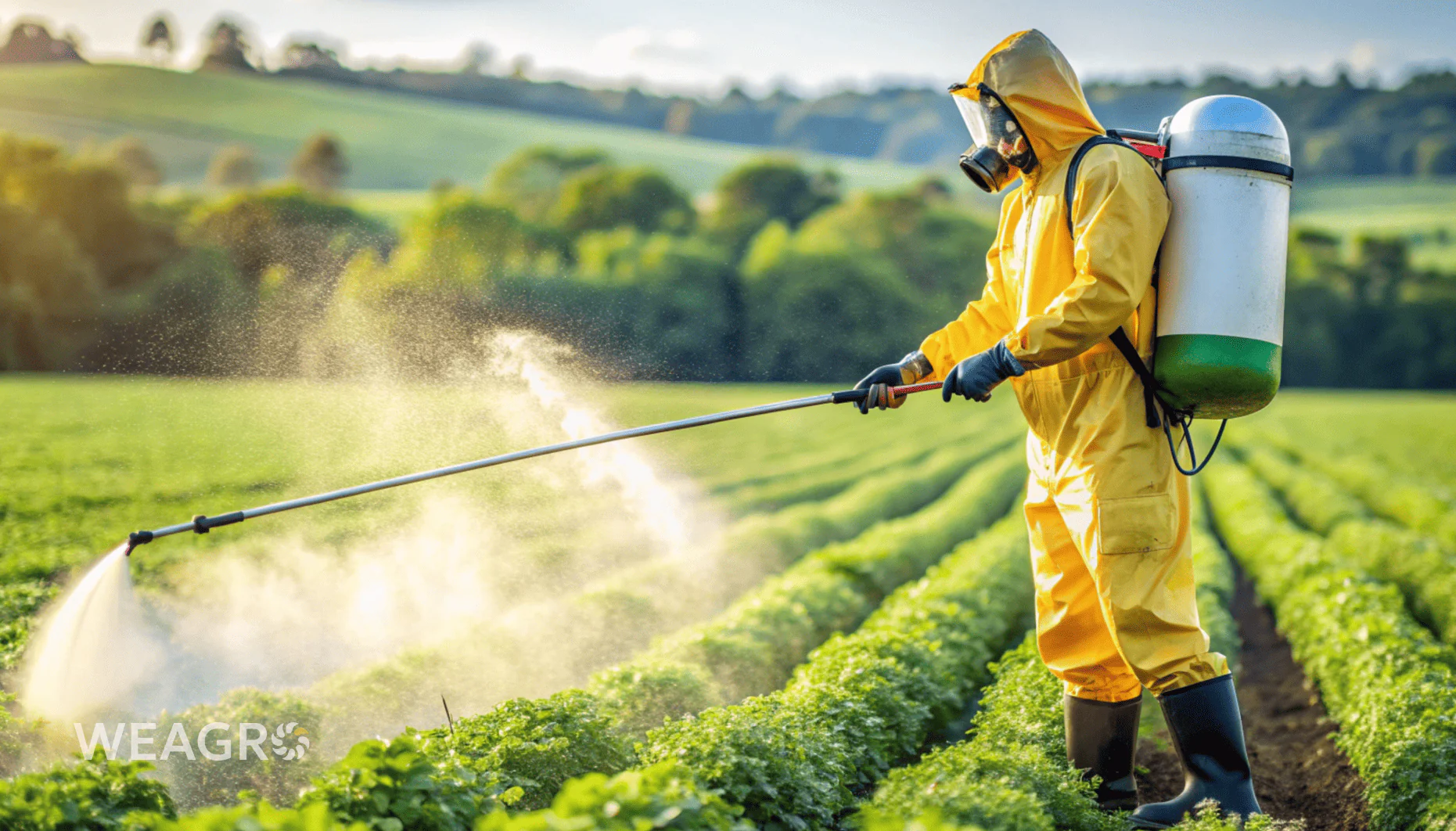In recent years, Ukraine has seen a trend of increasing sunflower cultivation areas, leading to crop rotation disruptions and accumulation of various disease pathogens in the soil. According to research, crop losses can range from 20-100% depending on the pathogen. This poses serious risks for farms growing the crop for sale. In this article, we will examine the main types of sunflower diseases and methods to combat them.
Causes of Sunflower Diseases
The development and spread of sunflower diseases are influenced by a complex of factors, with the main ones being:
- Weather conditions — prolonged periods of high air humidity, frequent rainfall, and fog create a favorable environment for fungal spore germination and plant infection. This is especially critical during the flowering and seed filling periods.
- Accumulation of infection in the soil — occurs due to violation of scientifically based crop rotations, continuous cultivation of the crop, or returning it to the same field earlier than recommended. This leads to the preservation and increase of pathogen resting structures: sclerotia, oospores, pycnidia.
- Infection through insects and plant residues — many pathogens spread through vectors, such as aphids. Additionally, crop residues serve as a place for infection preservation and should be properly incorporated into the soil.
- Reduced plant immunity — crops weakened by unfavorable conditions or lack of nutrients are more susceptible to diseases. Therefore, it is important to provide the crop with everything necessary for growth and development.
To protect sunflowers from diseases, it is necessary to follow crop rotation, returning the crop to the field no earlier than 6-9 years. Deep fall plowing, destruction of plant residues, and planting resistant hybrids also help. In organic farming, fertilizers such as composts, green manures, and biological products are used to enhance plant immunity. This is a safe alternative to chemical fungicides.

Read also: Organic fertilizers: what they are, types and application rates
Sunflower Diseases
The most common and harmful sunflower diseases in Ukraine are associated with leaves, stems, and heads.
Sunflower Leaf Diseases
The main sunflower leaf diseases include:
- Downy mildew (peronosporosis) — a very dangerous disease caused by the oomycete Plasmopara halstedii. Signs: chlorotic, randomly located spots form on the upper side of the leaves, and a white cobweb-like coating of fungal sporulation appears on the lower side. This leads to growth retardation, wilting, and plant death. Affected crops look like a mosaic of sick and healthy plants. The infection persists in the soil for 7-8 years. Control measures — planting resistant hybrids, biofungicides.
- Alternaria (dry spot) — the causative agent is the fungus Alternaria helianthi. On leaves, stems, and later on sunflower heads, small dark brown spots of irregular shape with concentric rings appear and grow. With severe development, the spots merge, affected leaves turn yellow and dry prematurely, stems and heads turn brown. The infection persists on plant residues and seeds. Warm and humid weather promotes development. Control — deep fall plowing and biofungicides.
- Septoria leaf spot — affects leaves, the main symptom is round gray spots 5-15 mm with a dark border, on which black dots later form — pycnidia of the fungus Septoria helianthi. The source of infection is plant residues. It develops in humid regions. Control measures are the same as for Alternaria.
Regular crop monitoring and application of preventive measures will help maintain the health of sunflower leaves.
Sunflower Stem Diseases
Although there is an opinion that bacterial diseases of sunflower are the most dangerous, fungal diseases cause the main damage:
- Sclerotinia (white rot) — there are three forms: basal, stem, and head. Signs — wilting and lodging of plants, white cotton-like mycelium, sclerotia. They persist in the soil for 8-12 years. Factors promoting development include humidity above 60% and frequent precipitation. Control — crop rotation, destruction of plant residues, organic fungicides, biological products with antagonistic fungi.
- Phoma stem canker — signs — distinct black spots on stems 2.5-5 cm, concentrated near the base of the petiole. Infection starts from the lower leaves. Control — planting healthy seed material, biological fungicides.
- Gray stem spot (phomopsis) — causes large brown necrotic spots around petioles, pycnidia. Leaves are affected first. Frequent downpours promote development. Yield losses up to 50%. Control measures are the same as for phoma.
A comprehensive approach to protection, including proper agricultural techniques and the use of resistant varieties, will help minimize risks from fungal and viral sunflower diseases.
Sunflower Head Diseases
The head is the most important plant organ that directly affects seed yield. Pathogen infection can lead to significant economic losses. Let’s consider the most common sunflower head diseases:
- White rot — the back side is covered with a cobweb-like mycelium between the seeds, black sclerotia. Heads become loose and disintegrate.
- Gray mold — signs and control measures are similar to white rot. Develops in high humidity. Causes rotting of heads and seeds, reducing oil content by 10%.
Timely application of preventive and protective measures, especially during critical phases of plant development, will help preserve plants from fungal and bacterial sunflower diseases and maximize yield.
Read also: Sunflower: price outlook, cultivation technology and conditions
Sunflower Pests
Numerous insects cause no less damage. Depending on the location and nature of the damage, they are divided into groups:
- Seedlings — damage sprouts, gnaw or suck them, leading to thinning of crops. The most dangerous: sand darkling beetle, seedling fly, and beet flea beetles.
- Roots and lower part of the stem — wireworms, false wireworms, and cutworms gnaw, damage roots and the basal part, causing wilting and death of young plants.
- Leaves — meadow moths, owlet moths, and bugs feed on leaves, reducing the assimilation surface.
- Heads and seeds — sunflower moth and plant bugs damage embryos during the filling and ripening phase.
Let’s consider the biological features and control measures for the main types of insect pests:
- Wireworms — larvae of click beetles. They damage seedlings and young plants, gnaw seeds, the underground part of the stem, and chew through roots. Plants wilt and dry up. They cause damage for 3-4 years, overwinter in the soil, burrowing up to 50 cm deep. Plant protection from sunflower pests — crop rotation, mechanical soil cultivation, application of bioinsecticides.
- Sand darkling beetle — beetles 7-10 mm long, black or gray-brown, lacking hind wings. They are especially harmful to seedlings near forest belts where they overwinter. In spring, beetles emerge and start gnawing leaves and stems of young plants, leading to their death and crop thinning. The nature of damage — rough gnawing along the edges. Economic threshold of harmfulness (ETH) — 3-5 beetles/m². Control methods: early sowing, organic fertilizers, and bioinsecticides.
- Meadow moth — butterflies with a wingspan up to 28 mm, front wings brown-gray with a lighter pattern, hind wings grayish-white. Caterpillars are greenish-gray with dark stripes, 25-30 mm long. One individual consumes 10-15 cm2 of leaf during development. Initially, caterpillars skeletonize it, leaving a network of veins, then gnaw the blade from the edges, leading to its drying. ETH — 8-10 caterpillars/m². Sunflower pest protection measures: plowing, weed destruction, and release of Trichogramma.
- Sunflower moth — butterfly with a wingspan of 18-23 mm, front wings brownish-gray with darker lines and dots. Caterpillars are yellowish-white with a brown head and shield on the prothorax, 16-18 mm long. Pests enter the head, damaging flowers, ovaries, and seeds. Feeding on the contents, a caterpillar can destroy up to 10 seeds. With heavy infestation, up to 30% of the crop can be damaged by the moth, reducing its germination and oil content. Control — deep fall plowing and growing resistant varieties.
Protection against sunflower stem pests and other localizations in organic farming is based on preventive measures: optimal agricultural techniques, mechanical control, and application of biomethod (entomophages).
Our online service provides Ukrainian farmers with the opportunity to quickly, conveniently, and without overpayment purchase goods with deferred payment for effective crop protection. Any purchase and sale agreements between farmers and suppliers can be concluded on the online service. Our digital solutions WEAGRO allow working with small farms up to 500 hectares without collateral and unnecessary documents. We help farmers optimize costs when purchasing plant protection products and fertilizers, increasing profitability.
Conclusion
For effective protection against sunflower pests and diseases, it is necessary to apply a comprehensive organic farming system that includes:
- adherence to scientifically based crop rotation;
- high-quality soil cultivation, destruction of plant residues;
- planting healthy seed material, resistant varieties and hybrids;
- application of organic fertilizers, green manures to enhance plant immunity;
- mechanical methods of pest control;
- biological protection — use of entomophages, biofungicides, and bioinsecticides;
- digital precision farming technologies for crop monitoring and decision-making.
Implementation of organic protection systems against sunflower diseases using our online service tools will allow Ukrainian farmers to minimize crop losses, obtain environmentally friendly products, while preserving soil fertility and the environment. Using convenient financial solutions — installment plans from WEAGRO will help agricultural producers optimize costs and increase the efficiency of their farms.









